Brenna Matendere
THE exploitation and mining of rough diamonds by Chinese firm Anjin Diamond Company in the Chiadzwa area of Manicaland province has led to a sharp rise in malaria cases due to poor environmental management practices.
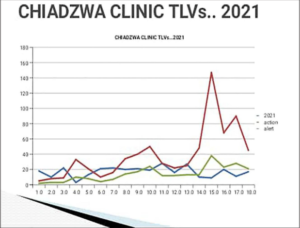
The company has over the years left numerous unreclaimed pits and slime dams. The development has also put the spotlight on the Environmental Management Agency (Ema) which is accused of failing to enforce the country’s environmental laws. Anjin has over the years left large pits, gullies and slime dams many of which are filled with stagnant water.
They have become breeding grounds for mosquitoes. As a result, malaria cases in Chiadzwa have increased, while the pits have claimed lives and are posing serious danger to humans and wildlife. Anjin Diamond Company is a joint venture between China’s Anhui Foreign Economic Construction Company (AFECC) and Matt Bronze, an investment vehicle controlled by Zimbabwe’s military.
The firm started operating in Chiadzwa in 2010 but was ordered to shut down in 2016 when the government ceased operations of all diamond companies in the area after the then president Robert Mugabe claimed there were serious leakages of the gems amounting to US$15 billion.
The ban led to the establishment of the state owned Zimbabwe Consolidated Diamond Company (ZCDC) which then took over operations.
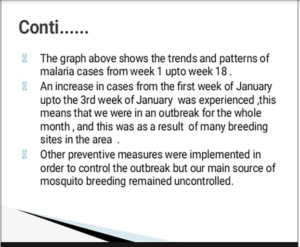
When President Emmerson Mnangagwa took over leadership of the country in a military coup in November 2017, he lifted the ban on Anjin’s operations, resulting in the company resuming full-scale diamond mining in Marange with an initial investment of US$38 million in 2019.
However, investigations by The NewsHawks with support from Information for Development Trust under a project meant to support investigative reporting focusing on the accountability and governance of foreign interests and investments in Zimbabwe and Southern Africa, revealed that Anjin’s operations have resulted in serious land degradation in areas it has been exploiting diamonds.
Some of the open pits have not been rehabilitated since 2010. A recent visit to Chiadzwa, by this reporter revealed there many pits holding stagnant water.
The pits have become a haven for mosquitoes, causing a spike in malaria cases as confirmed by villagers, community leaders, and documents prepared by ministry of Health and Child Care officials as well as civil society organisations operating in the area.
A physical count revealed that in Muedzengwa Village which is located in ward 30 of Marange, there are eight deep pits left unrehabilitated by Anjin.
In nearby Chirasika Village there are six pits while in Tinoengana Village there are 15, bringing the total to 29 in the three villages alone.
A total of 12 villages, namely Chiadzwa, Chibiya, Mwaora, Farikai, Makotamo, Tarindwa, Rambai, Charamba, Tonhorai, Muedzengwa, Chirasika and Tinoengana are bearing the brunt of mosquitoes breeding in the pits, resulting in an upsurge in malaria cases.
The villages are spread between Marange’s wards 29 and 30. Investigations by this publication also revealed that Anjin over the years has not attempted to carry out land reclamation and gully filling in the affected areas in line with its Environmental Impact Assessment (EIA) plan approved by Ema.
The company’s spokesperson confirmed the existance of the pits but said Anjin had a reclamation plan which would be rolled out this year.
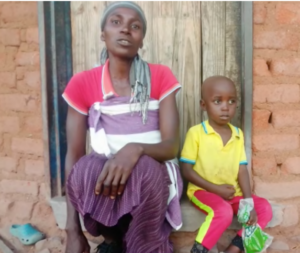
Prosper Mapindu also contracted the disease
Malaria victims speak out
In an interview recorded on camera, Shylet Mapindu of Tonhorai Village located in ward 29 of Chiadzwa revealed she contracted malaria two times last year. Her three-year-old son, Prosper Mapindu, also contracted the disease.
“Each time that rains fall in this area, water gathers in the deep pits left by Anjin. Mosquitos are breeding there in large numbers and because of that we are enduring mosquito bites and we have many malaria cases in the area. Personally, I contracted malaria twice last year. The hospital is too far so I went to a nearby village health worker, who has testing kits,” Mapindu said.
“She put me on a malaria course and unfortunately my child here also faced the same situation He is three-years-old but he battled malaria at such a tender age.”
Besides causing malaria, Mapindu said the mosquitos were a nuisance and making life unbearable for villagers.
“In our huts here, you can hardly sleep at night due to the mosquitoes which will be giving us hard times. Some officials from the ministry of Health once came to do door-to-door spraying, but that did not help much. The mosquitoes are still plenty and we are enduring the bites daily,” she said.
Another villager, Aleck Taranga, who contracted malaria in February this year, said: “The open pits with stagnant water left behind by Anjin are a very big problem for us. I contracted malaria in February this year, but the challenge is that we do not have a clinic nearby. From my home in Tonhorai village to Chishimwi Clinic, the nearest health facility, it’s about 14 kilometres. “There is no transport to reach there so for you to walk that distance while ill it is very difficult. So, like many people, I just went to the village health worker, got tested and was given my malaria course after diagnosis. We have a big malaria problem here.”
Tonhorai village headman Onias Chinyadzwa said he and other villagers have in the past approached Anjin over the slime dams and pits.
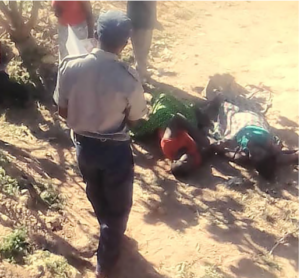
He however said Anjin had not taken action to rehabilitate the pits.
“We are now thinking of going back to the company to highlight to them the increasingly devastating problem of malaria in our area caused by their slime dams. Because of the rains, the pits and slime dams have been filled with stagnant water. Mosquitoes are breeding there and malaria cases are rising,” he said.
Some village health workers from Chiadzwa confirmed the upsurge in malaria cases although they said they could not comment because they work under the ministry of Health and Child Care and are not authorised to speak to the media.
“What we do is that we collect malaria test kits and medication from major health centres like Chiadzwa Clinic. We then go back to work in our areas. In terms of malaria, in my community I handle an average of 25 to 45 cases of malaria a month and that is quite very high,” said a community health worker.
“We have been having such a trend for some time. From my own observation, I believe the ministry of Health is not keen to make public these statistics because, we have strict orders not to reveal the statistics to anyone. It’s a dismissible offence for us.”
The Environmental Management Act is the legal statute which provides for land reclamation after mining projects. Section 107 of the law says that land developers who include mining companies must “minimize adverse effect of (their) projects on the environment.”
Section 107 (1) reads: “Every developer shall take all reasonable measures to prevent or, if prevention is not practicable, to mitigate any undesirable effect on the environment that may arise from the implementation of his project.” Those who violate the Act can also be fined or imprisoned in line with section 97 of the Act.
Section 97 (2) and (3) says: “Subject to sub-section (4) any person who knowingly implements a project in contravention of subsection (1) shall be guilty of an offence and liable to a fine not exceeding ten million dollars or to imprisonment for a period not exceeding five years or to both such fine and such imprisonment,” the Act reads.
“The Agency may serve an order in terms of sub-paragraph (xiii) of subsection (1) of section ten on a person who knowingly implements a project in contravention of subsection (1) ordering that person — (a) to mitigate the effects of any adverse environmental impact in the manner specified in the order.”
Amalgamated Chiadzwa Development Communities Trust (ACDCT) Marange chapter chairperson Jey Kasakara told The NewsHawks that malaria cases in Chiadzwa are a cause for concern.
“From our interactions with environmental health technicians in our area, almost every month there is an outbreak of malaria in Chiadzwa due to proximity of some villages to pits that were left open by Anjin and are now breeding grounds for mosquitoes,” he said.
“The stagnant waters are helping in the breeding of the mosquitoes, causing terrible bites to villagers, especially at night when the vector is active. We have held focus group meetings in the affected areas and villagers are bitter about the issue.
“In November last year, officials from the ministry of Health sprayed chemicals to kill the mosquitos in homesteads but that was not enough because they did not do anything at the pits where mosquitos are breeding. So, the problem is still existing,” he said.
James Mupfumi, the Centre for Research and Development (CRD) director, said malaria is affecting the education sector.
“From our research and information we gathered in the area, the issue of malaria is now spreading into the education sector where children are being affected by the disease resulting in poor pass rates of zero percent. We have also held focus group meetings in the area to discuss on the issue of malaria and I can say it’s a big problem that is affecting the community there,” Mupfumi said.
“All age groups are being affected by the mosquito bites but the problem seems to be bigger on children under the age of five. The source of the problem are pits left behind by Anjin which are now a breeding hub for mosquitoes.”
Manicaland provincial medical director Munyaradzi Mukuzunga however professed ignorance on the malaria cases in Chiadzwa.
“I have never heard about the malaria cases. I have over 200 health centres which I preside over in Manicaland, so I cannot know everything that happens in all these centres. It is impossible. Maybe you can check with people who live around that area, but no one has ever told me about that problem of malaria in Chiadzwa,” he said.
Ministry of Health/CSO reports confirm malaria cases linked to mining. However, a report compiled by an environmental health technician employed by the ministry of Health titled “Environmental Health Impacts of Mining, Lessons drawn from Marange” presented at a policy dialogue meeting held on 9 December 2021 in Mutare confirmed malaria was on the rise, as a direct result of mining.
The meeting was attended by various stakeholders, including the Centre for Research and Development, village health workers, ministry of Health officials, villagers from Marange and traditional leaders.
Part of the report reads: “Before mining in Chiadzwa, the area was characterised by high temperatures of about 37 to 40 degrees Celsius receiving rainfall of about 28mm per annum.
Occurrence of diseases was limited since there were no movements of people to the area,” the report reads.
“Malaria became a problem in the area for the past nine years. From 2010 backwards there were no high cases of malaria recorded.
“Highest number of malaria cases were recorded during the time when Anjin started mining activities. More than 100 cases in a month were once recorded for the period of 2016 and 2017. This was worst situation we experienced as health workers at Chiadzwa clinic.
“In 2021, Malaria cases surpassed the malaria threshold limit value for the following weeks, week 1, week2, week 3, week 6 and 7 as well as week 11 and 13.
“An increase in cases from the first week of January up to the third week of January was experienced, this means that we were in an outbreak for the whole month, and this was a result of many breeding sites in the area.”
The report says environmental factors such as high temperatures speed up the life cycle of a vector (anopheles mosquitoes) hence the high number of malaria cases.
“Studies were carried out and entomological surveillance was conducted in the area. A number of breeding sites around Chiadzwa and Chishingwi area were discovered with presence of larvae at 3rd and 4th insta,” the report reads.
“There is evidence that the area is infested with vectors. These open ponds left during mining by Anjin are a problem as surveys conducted by Ministry of Health and Child Care in June, September, October and November 2021 found out that open ponds were source of mosquito breeding.
“We experienced outbreaks on malaria almost every month and we conducted outbreak investigations, entomological surveillance, bio-laviciding, health education on Malaria. However even though these measures were being implemented, there is need for land reclamation, gully filling to reduce mosquito breeding sites in Chiadzwa.”
ACDT and CRD also conducted a survey in Marange to assess the malaria situation in 2020 by talking to villagers and village health workers. The survey established that four villages in Marange’s Chishingwi area were malariuos.
These are Kusena which is home to 1 141 villagers, Rombe with 909 people, Jessi area with 195 people and Muyedzengwa which had a population of 148 people.
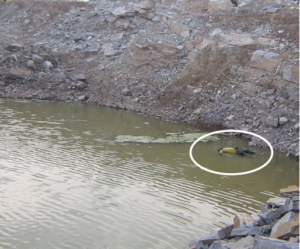
Death in Anjin pools
While the issue of malaria has become topical in the area, there are other emerging hazards including loss of lives being caused by the unrehabilitated pits left by Anjin.
Newman Chiadzwa, who resides in the area and is related to headman Chiadzwa, said in November 2021 a woman committed suicide in one of the pits together with her two children. Chiadzwa spoke in an interview with The NewsHawks during the visit.
The children were aged two weeks and three years. The incident happened at a pit left by Anjin in Muedzengwa Village of Marange.
“The pits left by Anjin are now a menace for human life due to causing of diseases as well as putting lives in danger. We are in trouble,” he said. On 30 April 2019, two women also died in one of the pits which resemble small dams while fishing.
The NewsHawks obtained still photos of police attending to the scene where the bodies had been retrieved. CRD confirmed the deaths.
Ema acknowledges environmental woes
Ema’s national spokesperson Amkela Sidange said Anjin had a valid environmental impact assessment licence. “On the issue of the pits that have been left open, yes the agency is already working on that after also realising that there is a loophole by the same company,” she said.
“The agency has been informed by the company that some of the pits, they still want to rework them, so they cannot cover them up because they still intend on coming back to work on them. So, what we are now doing at the moment; we are working with this company (Anjin) to actually come up with the comprehensive database on the number of pits that they have. It would be better to bring this up early in the story, to say Ema acknowledges that there is an issue.
We are also establishing the pits that they want to rework, so that at the end of the day we are able to then come up with a figure of pits that they are saying they are no longer going to rework on them. This is then going to assist us to then issue them with an order to back fill these open pits that they are saying they are no longer going to rework.”
She added: “At the same time for those that they are saying they are going to rework on we must ensure that they are fenced off such that they don’t pose any risk be it to the livestock or to humans. So yeah basically, that’s what is happening there and the intention is to ensure that the pits that are going to be rehabilitated, we make sure that Anjin is given an order to have them backfilled to such an extent that the land can also be put into other use or rather it become reusable for other productive purposes.”
We have a rehabilitation plan: Anjin
Anjin spokesperson, Special Matarirano, said the company has a plan to rehabilitate the deep open pits and slime dams this year.
He insisted that Anjin had not violated any environmental laws. “Anjin Investments (Private) Limited is a diamond mining company which has a high regard of Zimbabwe’s national environmental laws. In fact, the company has and is compliant to all environmental legal and social requirements of the country,” Matarirano said.
“The company has an approved environmental rehabilitation plan, which is set to be launched this year and this is on the company’s environmental priority projects where a total of 7 hectares of land is set to be rehabilitated and populated with different fruit trees.”
Matarirano said Anjin had not filled the pits or rehabilitated the land since 2016 because the Chinese company is considering re-working the land.
“Key to note is also the fact that Anjin is still doing some re-explorations in the formerly alluvial mined areas, the exploration is mostly to determine the existence of the conglomerate in such areas,” he said.
“Hence some gullies which are in areas with potential mineral resources are not filled. In such areas where exploration is ongoing, slime dams and pits are continually being fenced. We are fencing off the areas to secure them from intrusion by humans as well as livestock,” he said.
Asked whether Anjin was aware that malaria cases are emerging around the area of Chiadzwa due to the high breeding of mosquitos in stagnant waters inside the pits that Anjin left unrehabilitated, Matarirano said the problem will be dealt with when the company completes its plans to be unrolled this year.
He claimed the company has been treating the water in the gullies to curb mosquitoes from breeding.
“Our rehabilitation action plan, that which we are launching this year, covers the hectarage we believe require immediate action on gullies, that’s the 7 hectares I mentioned earlier. One thing is that the company is quite awake and aware of its environmental protection duty and preservation of ecosystems, human and animal life in all its operations,” Matarirano said.
“The slime dams are a controlled water body which we drain whenever there is possibilities of health effects and or treated to disallow mosquitos from breeding. Anjin is a company that has a raison de’tre and has health security and safety on its priority of operations,” he said.
However, during the site visit to Chiadzwa last month, the measures which Matarirano spoke about such as securing the areas with the pits, draining water as well as treatment to disallow mosquito breeding, were not evident.
Photographs taken this week showed that the company is yet to implement these measures. Ema’s Sidange called upon mining companies in general to be environmentally friendly in their operations.
“It is actually our call as the agency really to those that are in the mining sector to ensure that they always rehabilitate after mining. To ensure that land is brought back into its natural state, and it can also be put into productive use and at the same time as a way of ensuring that we protect humans as well as animals,” she said.
While Anjin and Ema work on a rehabilitation plan, malaria cases continue to rise among Chiadzwa villagers, who are also angry because they have not benefitted much from diamonds being exploited in their area.


Comments are closed.